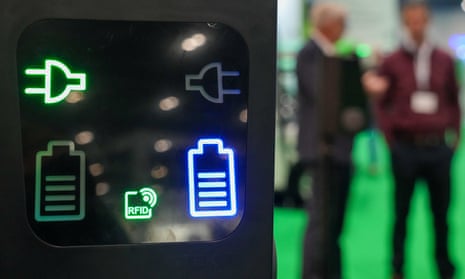
Europe is ‘miles behind’ in race for raw materials used in electric car batteries
EU and UK carmakers have secured just 16% of lithium, cobalt and nickel needed to hit 2030 targets, says study
European carmakers have secured less than a sixth of the key raw materials they will need by 2030 to make electric vehicle batteries, according to analysis that highlights the expected scramble for green-tech resources.
Carmakers have secured contracts for 16% of the lithium, cobalt and nickel required to hit their 2030 electric car sales targets, according to public disclosures analysed by Transport & Environment (T&E), a Brussels-based campaign group.
The world’s two biggest electric carmakers, Tesla in the US and China’s BYD, were significantly further ahead of many of their European rivals in securing access to key raw materials, the researchers found.
Batteries used in devices ranging from mobile phones to cars are made of precisely controlled combinations of metals. There is a global race to find enough lithium, the lightest metal, but cobalt and nickel are also important in many batteries.
The analysis suggested carmakers had disclosed agreements that would cover only 14% of the lithium, 17% of the nickel and 10% of the cobalt needed to meet their targets for 2030. The EU and UK will ban the sale of new fossil fuel cars in 2035.
Julia Poliscanova, the senior director for vehicles and emobility at T&E, said: “There is a clear disconnect between carmakers’ electric vehicle [EV] goals and their critical mineral strategies. Tesla and BYD are way ahead of most European players, who are only waking up to the challenge of securing battery metals now.”
T&E said Mercedes-Benz, BMW and Hyundai/Kia were the carmakers with large European operations that were lagging furthest behind rivals. Ford, Volkswagen and Stellantis have disclosed plans for battery mineral supply that rival Tesla and BYD.
Some of the carmakers may have secret deals with mining or refining companies to supply enough minerals, while some are looking at ways of reducing or eliminating the use of expensive cobalt and nickel. Nevertheless, the scale of the undersupply detailed in publicly disclosed contracts suggested carmakers would have to battle to hit their electric targets.
The analysis tallies with forecasts from the data company Benchmark Mineral Intelligence that demand for some key materials will significantly outstrip supply in the coming decade.
Benchmark predicts that lithium demand will quadruple by 2030 as China, Europe and then the US move rapidly away from petrol and diesel. However, its forecasts suggest there will be a lithium shortfall of 390,000 tonnes in 2030, compared with global production of 2.7m tonnes. It also predicts shortfalls of cobalt and nickel – part of what it describes as a “great raw materials disconnect” that could limit the pace of the transition away from petrol and diesel cars.
after newsletter promotion
Caspar Rawles, Benchmark’s chief data officer, said: “In the medium and even the long term, lithium is probably going to be the limiting factor on the rate that the battery industry can scale.”
Big mining projects usuallytook at least five years to start producing material at scale, and as long as seven years if fundraising was required, Rawles said. That would mean investment decisions would need to be made in the next year or two to increase supply by 2030.
Poliscanova said it was supply chain strategies that would “make or break the EV transition in Europe, and render some companies obsolete”. However, she added that European manufacturers were ahead of rivals from China and the US in “cleaning up supply chains”. Some mineral suppliers have previously been found to have used child labour, exploited low-paid workers or used environmentally damaging methods.